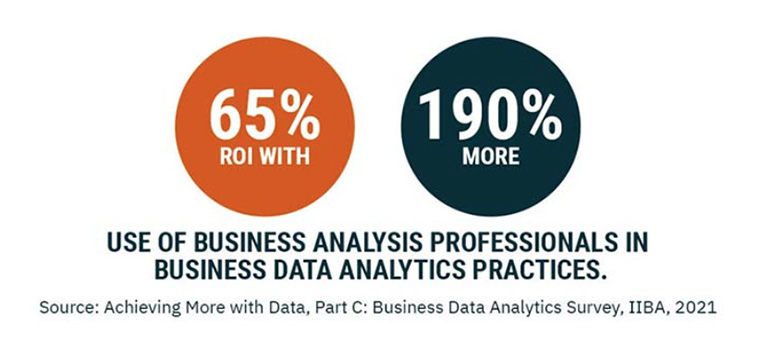Every Company is Now a Data Company and That’s a Good Thing
Receive free IIBA updates and exclusive content!
Think your company is a non-tech business just because it’s not part of the technology sector? Think again. These days, every company is a tech/data company. Moreover, that’s a good thing.

Why Is Your Company a Data Company?
Even if your organization hasn’t been included in the technology industry in the past, it’s still decidedly a data company if it has made it through the pandemic. In other words, it is a data company because it has to be.
The pandemic accelerated the rate of digital transformation, which forced organizations to quickly adopt tech such as AI and IoT. It also caused companies to rely less on their IT teams, which were already stretched thin, and to ensure all department leaders possessed some key tech skills. IT teams certainly have a place in modern companies, but they are no longer solely responsible for tech issues.
An article by LinkedIn by Global Business Leader Pavan Sethi stated,
“The past 18 months have proved beyond question that ‘every company is now a technology company.’ In just a few months, the pandemic catalyzed years of change in how organizations operate.”
Due to pandemic-related changes in the workplace, have most departments within your organization become tech savvy enough to deal with various IT issues? Has your organization prioritized digital transformation and implemented various technologies at an unprecedented rate? If so, your company is a data company. This is good news.
Data Companies Get Better Business Results
Being a data company is a good thing. Sethi said organizations that invested in more technology in an effort to cope with pandemic-related disruptions are now thriving. IIBA’s Achieving More with Data shares high performing organizations saw 65% ROI with 190% more use of business analysis professionals utilizing business data analytics practices.
In 2019, Accenture’s Global Future Systems Research (featuring enterprise technology strategies and their impact on organizational performance) indicated that leaders in tech were enlarging revenues at twice the rate of the bottom 25% of companies surveyed, Sethi explained. Just 10% of the companies surveyed could be identified as leaders in technology.
“Fast forward to early 2021 and we found that these tech leaders have surged even further ahead and widened the gap,” Sethi wrote. “They’re now growing on average over the past three years, at five times the rate of laggards.”
Clearly, data companies get better business results than organizations that don’t take adopting new tech and digital transformation seriously.
Core Technologies That Tech/Data Companies Use
In an article by ReadWrite, Timothy Carter, Chief Revenue Officer of a Seattle-based digital marketing agency, listed a few core technologies that most companies have needed to operate efficiently in the past couple years:
- Websites - No business can succeed without a website, which functions as a digital billboard for many. It’s also a place where individuals can research and purchase products and find information about the business.
- eCommerce platforms - These platforms are used by some businesses exclusively for sales. eCommerce platforms have been a lifesaver for retail businesses in the age of COVID-19.
- Customer portals - Customer portals are core tech for companies because they enable customers to review past purchases, subscribe or unsubscribe, and more. This level of accessibility cuts down on the number of live customer service agents a business needs.
- Marketing and advertising - Do you control digital marketing with analytics apps and automated bidding platforms? If so, you are in the company of many other businesses.
- Internal communications - The pandemic has increased businesses’ use of internal communication systems. Texting and calling are still widely used, but they aren’t enough to manage internal communications.
- Internal productivity – A number of businesses have purchased or plan to purchase internal productivity software. A great example of software that improves productivity is time-tracking software.
- Tracking and monitoring - Some forms of new technology enable businesses to track anything and everything. IoT systems help companies track inventory and products at all stages of operation, for example.
- Social media - It is the rare business that doesn’t leverage social media to engage its customers. Throughout the pandemic, businesses have used social media to connect with customers and sell products. Carter referred to social media as a “tech-focused extension of a brand.”
- Accessible customer service - Most companies are now using chatbots and live chats to promote better customer service. Additionally, they are offering more online resources to their customers, such as FAQ pages.
- Data analytics - No business can afford not to utilize data analytics to some degree. Without data analytics, organizational leaders can have no real idea of how well their company is performing or make impactful changes.
4 Ways to Embrace New Waves of Technology
According to an article by Forbes, organizations that quickly adopt new technologies have a competitive advantage over other businesses. But article contributor Stephanie Stone, CIO Americas at M+W Group, a global high-tech design and construction firm, said organizations that wait things out and jump in on the second or third waves of new tech never quite get the edge they need.Here are a few ways Stone recommends companies “embrace technology and crest the wave”:
- Understand how technology affects your business. To do this you will need to increase communication between all departments in your organization and stay connected.
- Understand how technology affects your customers. This may require you to increase your company’s engagement with customers, run analytics to see how customers are responding to the implementation of new technologies, etc.
- Accommodate the recurring wave of change. How? By trusting that IT has operations’ “best interests at heart and is willing and capable of taking on the task,” Stone said. Also, “IT must engage as partner, steward and advisor.”
- Embrace new ways of working - For Stone’s company, this looked like transitioning from traditional work streams into Agile work groups. For organizations going through the pandemic, this has meant adopting whatever mode of work is safest and best for the organization and its customers, be it remote, hybrid, or in-person.
Interested in expanding your digital and data practices?
Explore IIBA’s Certification in Business Data Analytics.
About The Author:

I’m passionate about advancing the global business analysis community. I lead a remarkable team responsible for all marketing, communications, brand & design, content delivery, lead generation, webinars & events, advertising, and related activities to nurture the growing demand for business analysis. With over twenty years of digital marketing leadership experience, most recently including the Silicon Valley start-up world, I help IIBA continue to evolve with the changing demands of the workplace and our diverse global membership.



